A Comprehensive Analysis of Tesla Motors: Performance and Strategies
VerifiedAdded on 2023/02/01
|9
|1661
|83
Report
AI Summary
This report provides a comprehensive analysis of Tesla Motors, focusing on its business operations, market position, and financial performance. It begins with an introduction to Tesla, its founding, and its role in the electric vehicle market. The report examines Tesla's size, type of business, and its competitors, including General Motors, BMW, and Toyota. It presents a qualitative and quantitative comparison of Tesla with its competitors, highlighting its strengths, weaknesses, and market share. The analysis includes financial ratios and key performance indicators. The report concludes with recommendations for improving Tesla's performance, such as streamlining technology, managing costs, and expanding into new market segments. Overall, the report offers insights into Tesla's current status and potential for future growth in the electric vehicle industry.
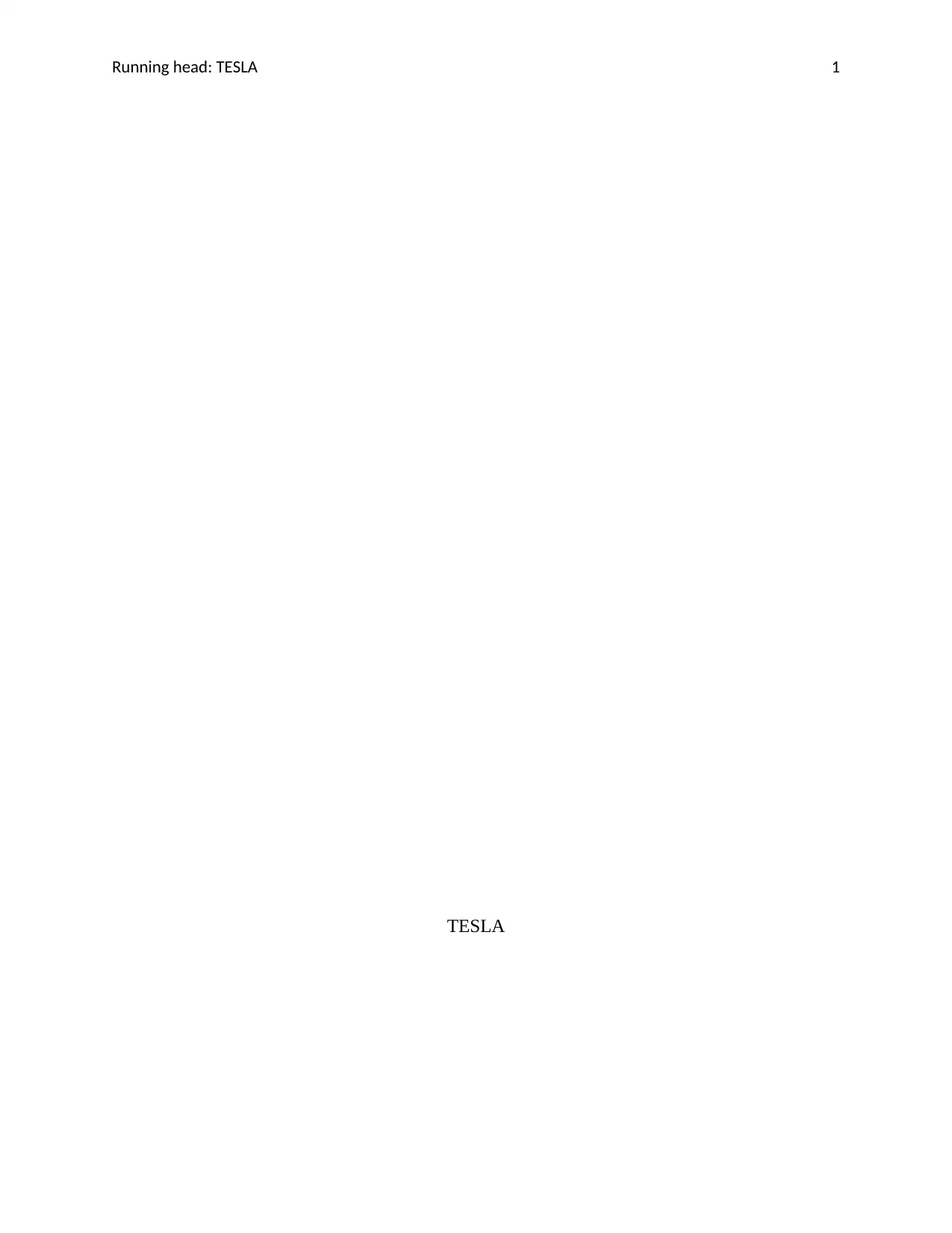
Running head: TESLA 1
TESLA
TESLA
Paraphrase This Document
Need a fresh take? Get an instant paraphrase of this document with our AI Paraphraser
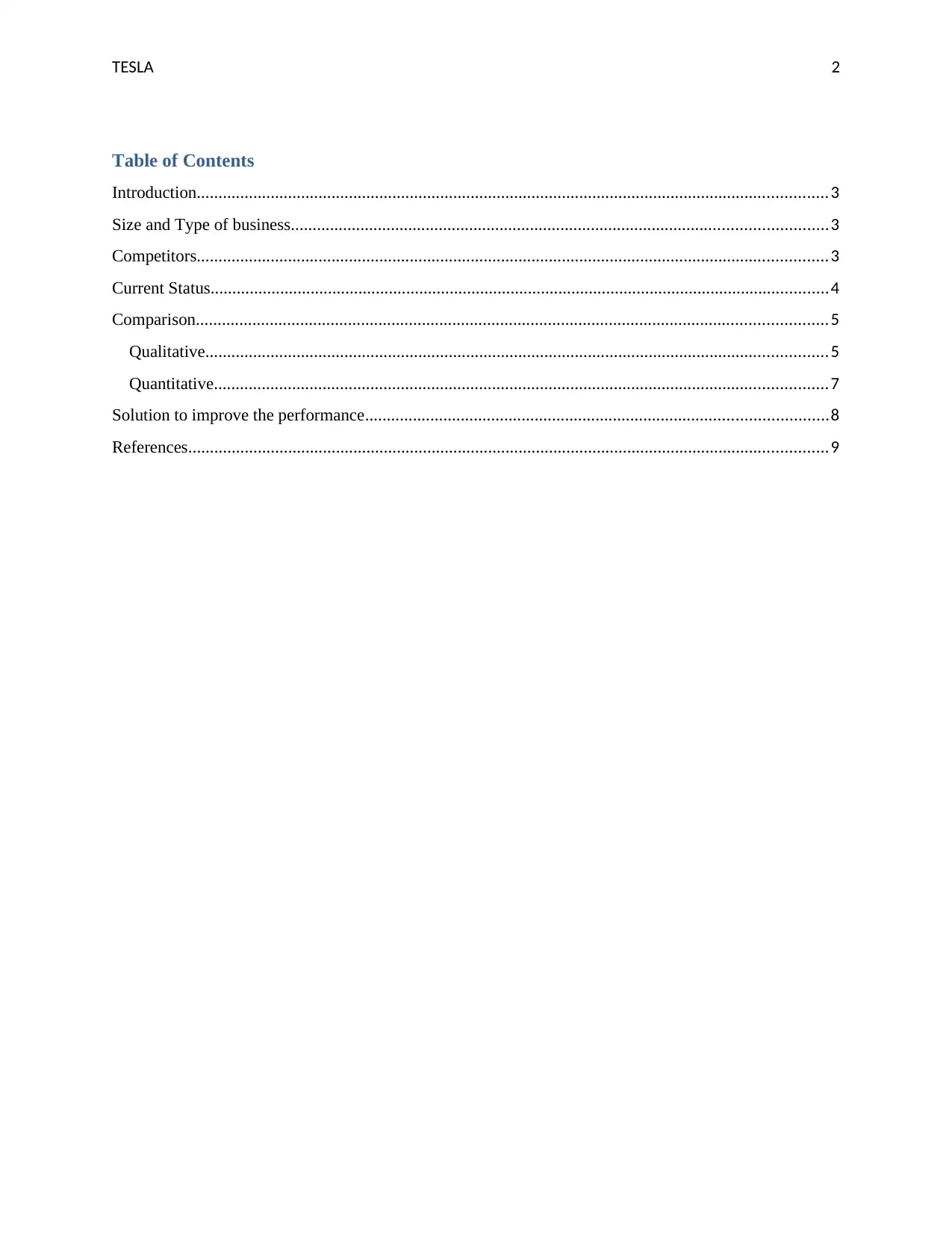
TESLA 2
Table of Contents
Introduction.................................................................................................................................................3
Size and Type of business...........................................................................................................................3
Competitors.................................................................................................................................................3
Current Status..............................................................................................................................................4
Comparison.................................................................................................................................................5
Qualitative...............................................................................................................................................5
Quantitative.............................................................................................................................................7
Solution to improve the performance..........................................................................................................8
References...................................................................................................................................................9
Table of Contents
Introduction.................................................................................................................................................3
Size and Type of business...........................................................................................................................3
Competitors.................................................................................................................................................3
Current Status..............................................................................................................................................4
Comparison.................................................................................................................................................5
Qualitative...............................................................................................................................................5
Quantitative.............................................................................................................................................7
Solution to improve the performance..........................................................................................................8
References...................................................................................................................................................9
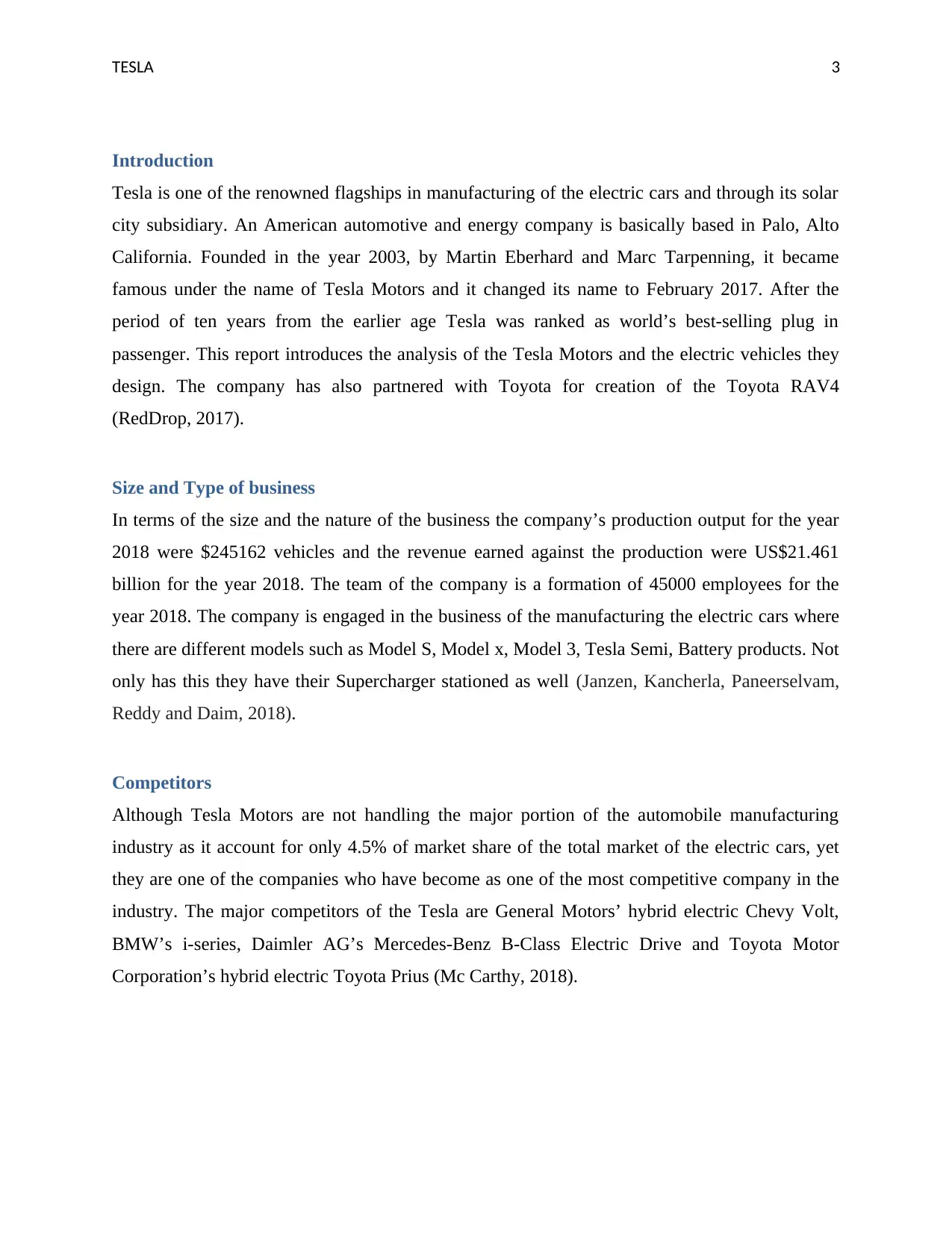
TESLA 3
Introduction
Tesla is one of the renowned flagships in manufacturing of the electric cars and through its solar
city subsidiary. An American automotive and energy company is basically based in Palo, Alto
California. Founded in the year 2003, by Martin Eberhard and Marc Tarpenning, it became
famous under the name of Tesla Motors and it changed its name to February 2017. After the
period of ten years from the earlier age Tesla was ranked as world’s best-selling plug in
passenger. This report introduces the analysis of the Tesla Motors and the electric vehicles they
design. The company has also partnered with Toyota for creation of the Toyota RAV4
(RedDrop, 2017).
Size and Type of business
In terms of the size and the nature of the business the company’s production output for the year
2018 were $245162 vehicles and the revenue earned against the production were US$21.461
billion for the year 2018. The team of the company is a formation of 45000 employees for the
year 2018. The company is engaged in the business of the manufacturing the electric cars where
there are different models such as Model S, Model x, Model 3, Tesla Semi, Battery products. Not
only has this they have their Supercharger stationed as well (Janzen, Kancherla, Paneerselvam,
Reddy and Daim, 2018).
Competitors
Although Tesla Motors are not handling the major portion of the automobile manufacturing
industry as it account for only 4.5% of market share of the total market of the electric cars, yet
they are one of the companies who have become as one of the most competitive company in the
industry. The major competitors of the Tesla are General Motors’ hybrid electric Chevy Volt,
BMW’s i-series, Daimler AG’s Mercedes-Benz B-Class Electric Drive and Toyota Motor
Corporation’s hybrid electric Toyota Prius (Mc Carthy, 2018).
Introduction
Tesla is one of the renowned flagships in manufacturing of the electric cars and through its solar
city subsidiary. An American automotive and energy company is basically based in Palo, Alto
California. Founded in the year 2003, by Martin Eberhard and Marc Tarpenning, it became
famous under the name of Tesla Motors and it changed its name to February 2017. After the
period of ten years from the earlier age Tesla was ranked as world’s best-selling plug in
passenger. This report introduces the analysis of the Tesla Motors and the electric vehicles they
design. The company has also partnered with Toyota for creation of the Toyota RAV4
(RedDrop, 2017).
Size and Type of business
In terms of the size and the nature of the business the company’s production output for the year
2018 were $245162 vehicles and the revenue earned against the production were US$21.461
billion for the year 2018. The team of the company is a formation of 45000 employees for the
year 2018. The company is engaged in the business of the manufacturing the electric cars where
there are different models such as Model S, Model x, Model 3, Tesla Semi, Battery products. Not
only has this they have their Supercharger stationed as well (Janzen, Kancherla, Paneerselvam,
Reddy and Daim, 2018).
Competitors
Although Tesla Motors are not handling the major portion of the automobile manufacturing
industry as it account for only 4.5% of market share of the total market of the electric cars, yet
they are one of the companies who have become as one of the most competitive company in the
industry. The major competitors of the Tesla are General Motors’ hybrid electric Chevy Volt,
BMW’s i-series, Daimler AG’s Mercedes-Benz B-Class Electric Drive and Toyota Motor
Corporation’s hybrid electric Toyota Prius (Mc Carthy, 2018).
⊘ This is a preview!⊘
Do you want full access?
Subscribe today to unlock all pages.

Trusted by 1+ million students worldwide
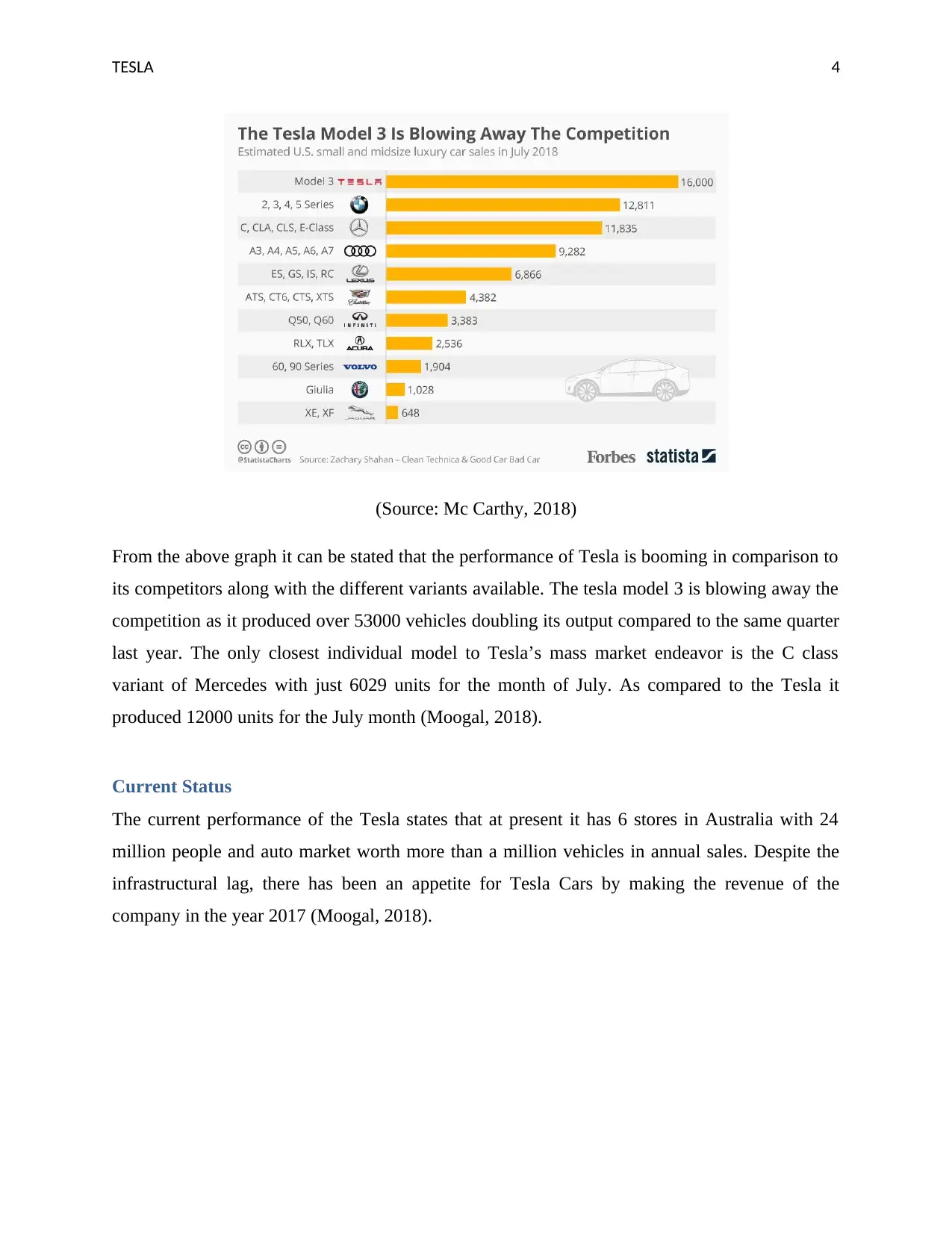
TESLA 4
(Source: Mc Carthy, 2018)
From the above graph it can be stated that the performance of Tesla is booming in comparison to
its competitors along with the different variants available. The tesla model 3 is blowing away the
competition as it produced over 53000 vehicles doubling its output compared to the same quarter
last year. The only closest individual model to Tesla’s mass market endeavor is the C class
variant of Mercedes with just 6029 units for the month of July. As compared to the Tesla it
produced 12000 units for the July month (Moogal, 2018).
Current Status
The current performance of the Tesla states that at present it has 6 stores in Australia with 24
million people and auto market worth more than a million vehicles in annual sales. Despite the
infrastructural lag, there has been an appetite for Tesla Cars by making the revenue of the
company in the year 2017 (Moogal, 2018).
(Source: Mc Carthy, 2018)
From the above graph it can be stated that the performance of Tesla is booming in comparison to
its competitors along with the different variants available. The tesla model 3 is blowing away the
competition as it produced over 53000 vehicles doubling its output compared to the same quarter
last year. The only closest individual model to Tesla’s mass market endeavor is the C class
variant of Mercedes with just 6029 units for the month of July. As compared to the Tesla it
produced 12000 units for the July month (Moogal, 2018).
Current Status
The current performance of the Tesla states that at present it has 6 stores in Australia with 24
million people and auto market worth more than a million vehicles in annual sales. Despite the
infrastructural lag, there has been an appetite for Tesla Cars by making the revenue of the
company in the year 2017 (Moogal, 2018).
Paraphrase This Document
Need a fresh take? Get an instant paraphrase of this document with our AI Paraphraser
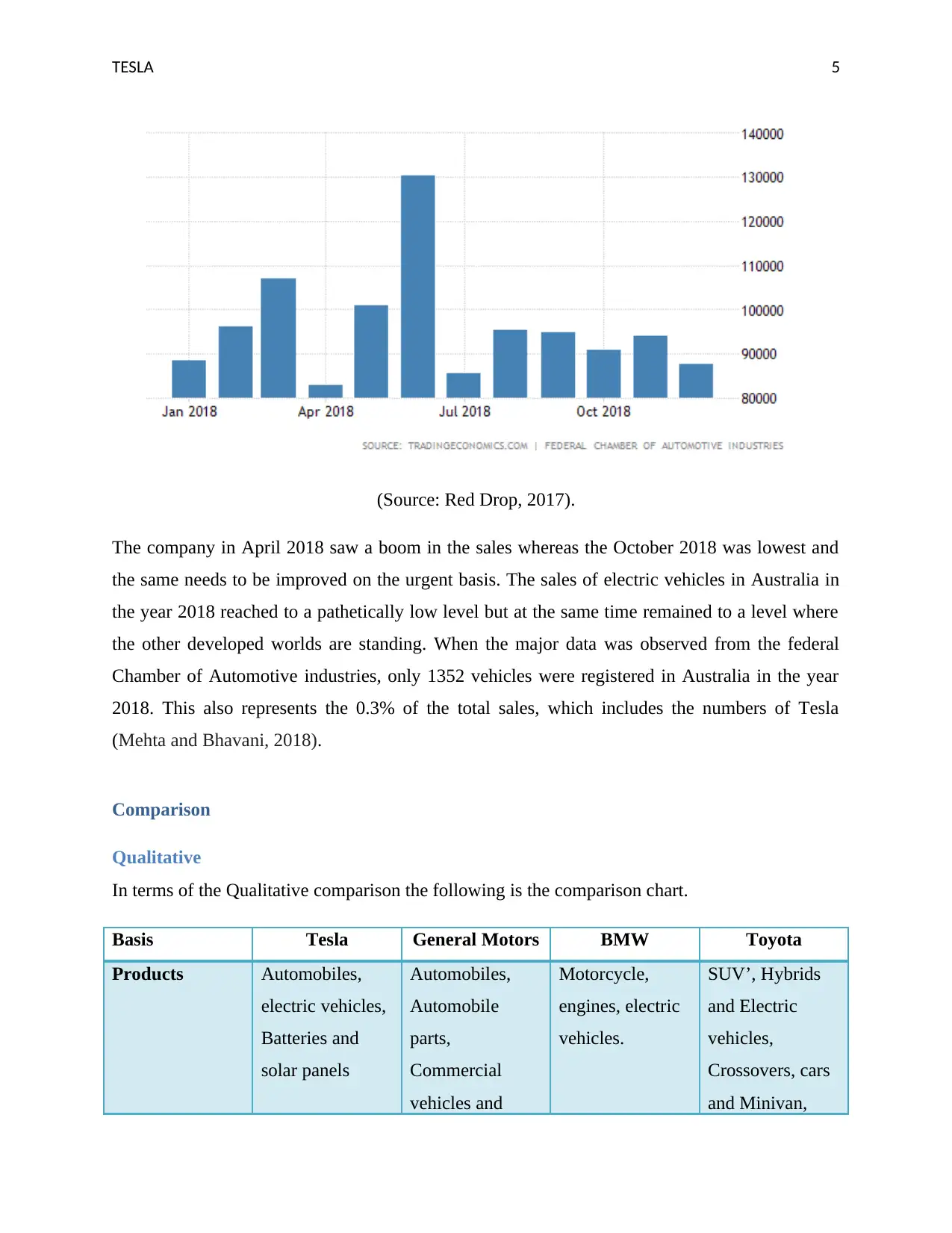
TESLA 5
(Source: Red Drop, 2017).
The company in April 2018 saw a boom in the sales whereas the October 2018 was lowest and
the same needs to be improved on the urgent basis. The sales of electric vehicles in Australia in
the year 2018 reached to a pathetically low level but at the same time remained to a level where
the other developed worlds are standing. When the major data was observed from the federal
Chamber of Automotive industries, only 1352 vehicles were registered in Australia in the year
2018. This also represents the 0.3% of the total sales, which includes the numbers of Tesla
(Mehta and Bhavani, 2018).
Comparison
Qualitative
In terms of the Qualitative comparison the following is the comparison chart.
Basis Tesla General Motors BMW Toyota
Products Automobiles,
electric vehicles,
Batteries and
solar panels
Automobiles,
Automobile
parts,
Commercial
vehicles and
Motorcycle,
engines, electric
vehicles.
SUV’, Hybrids
and Electric
vehicles,
Crossovers, cars
and Minivan,
(Source: Red Drop, 2017).
The company in April 2018 saw a boom in the sales whereas the October 2018 was lowest and
the same needs to be improved on the urgent basis. The sales of electric vehicles in Australia in
the year 2018 reached to a pathetically low level but at the same time remained to a level where
the other developed worlds are standing. When the major data was observed from the federal
Chamber of Automotive industries, only 1352 vehicles were registered in Australia in the year
2018. This also represents the 0.3% of the total sales, which includes the numbers of Tesla
(Mehta and Bhavani, 2018).
Comparison
Qualitative
In terms of the Qualitative comparison the following is the comparison chart.
Basis Tesla General Motors BMW Toyota
Products Automobiles,
electric vehicles,
Batteries and
solar panels
Automobiles,
Automobile
parts,
Commercial
vehicles and
Motorcycle,
engines, electric
vehicles.
SUV’, Hybrids
and Electric
vehicles,
Crossovers, cars
and Minivan,
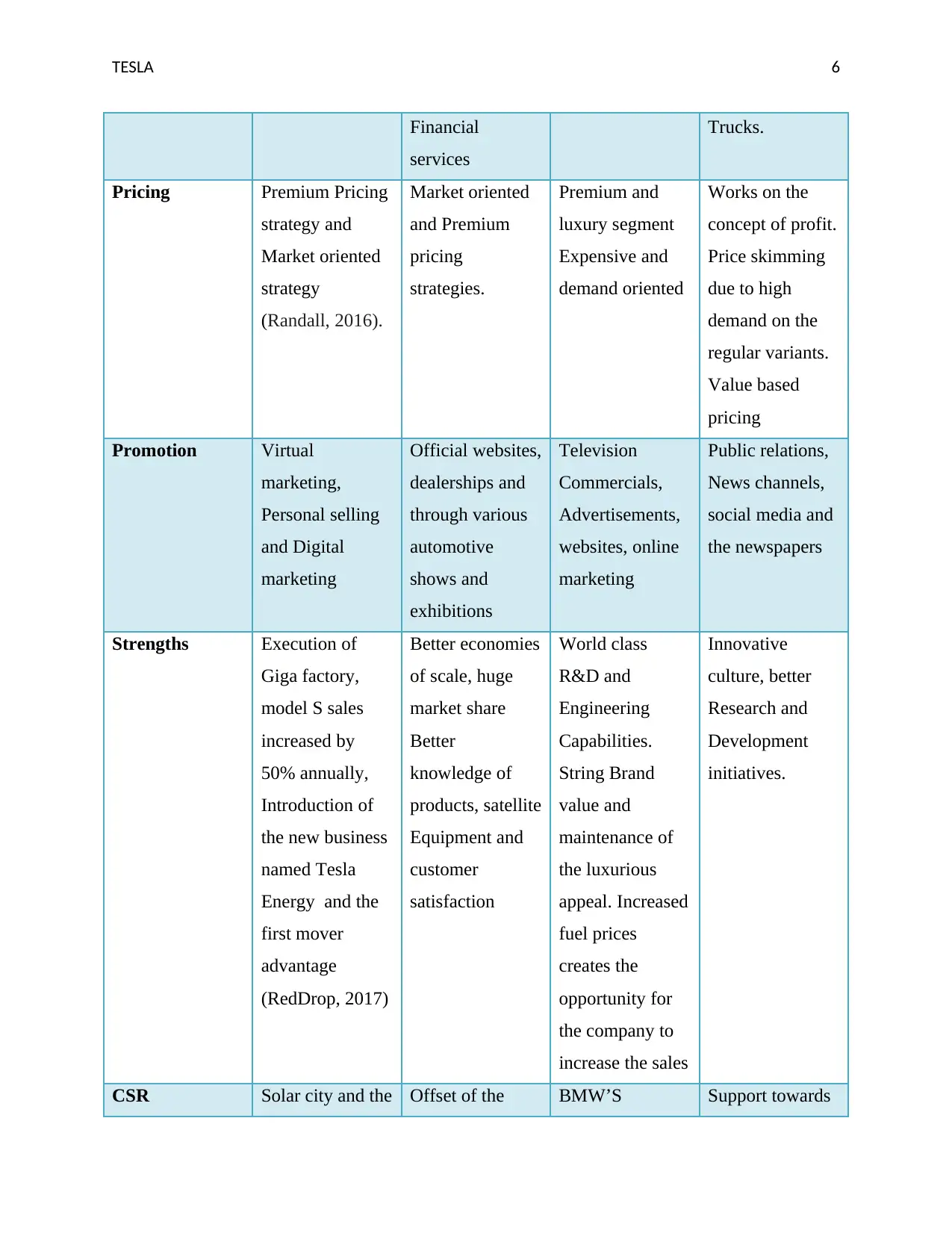
TESLA 6
Financial
services
Trucks.
Pricing Premium Pricing
strategy and
Market oriented
strategy
(Randall, 2016).
Market oriented
and Premium
pricing
strategies.
Premium and
luxury segment
Expensive and
demand oriented
Works on the
concept of profit.
Price skimming
due to high
demand on the
regular variants.
Value based
pricing
Promotion Virtual
marketing,
Personal selling
and Digital
marketing
Official websites,
dealerships and
through various
automotive
shows and
exhibitions
Television
Commercials,
Advertisements,
websites, online
marketing
Public relations,
News channels,
social media and
the newspapers
Strengths Execution of
Giga factory,
model S sales
increased by
50% annually,
Introduction of
the new business
named Tesla
Energy and the
first mover
advantage
(RedDrop, 2017)
Better economies
of scale, huge
market share
Better
knowledge of
products, satellite
Equipment and
customer
satisfaction
World class
R&D and
Engineering
Capabilities.
String Brand
value and
maintenance of
the luxurious
appeal. Increased
fuel prices
creates the
opportunity for
the company to
increase the sales
Innovative
culture, better
Research and
Development
initiatives.
CSR Solar city and the Offset of the BMW’S Support towards
Financial
services
Trucks.
Pricing Premium Pricing
strategy and
Market oriented
strategy
(Randall, 2016).
Market oriented
and Premium
pricing
strategies.
Premium and
luxury segment
Expensive and
demand oriented
Works on the
concept of profit.
Price skimming
due to high
demand on the
regular variants.
Value based
pricing
Promotion Virtual
marketing,
Personal selling
and Digital
marketing
Official websites,
dealerships and
through various
automotive
shows and
exhibitions
Television
Commercials,
Advertisements,
websites, online
marketing
Public relations,
News channels,
social media and
the newspapers
Strengths Execution of
Giga factory,
model S sales
increased by
50% annually,
Introduction of
the new business
named Tesla
Energy and the
first mover
advantage
(RedDrop, 2017)
Better economies
of scale, huge
market share
Better
knowledge of
products, satellite
Equipment and
customer
satisfaction
World class
R&D and
Engineering
Capabilities.
String Brand
value and
maintenance of
the luxurious
appeal. Increased
fuel prices
creates the
opportunity for
the company to
increase the sales
Innovative
culture, better
Research and
Development
initiatives.
CSR Solar city and the Offset of the BMW’S Support towards
⊘ This is a preview!⊘
Do you want full access?
Subscribe today to unlock all pages.

Trusted by 1+ million students worldwide
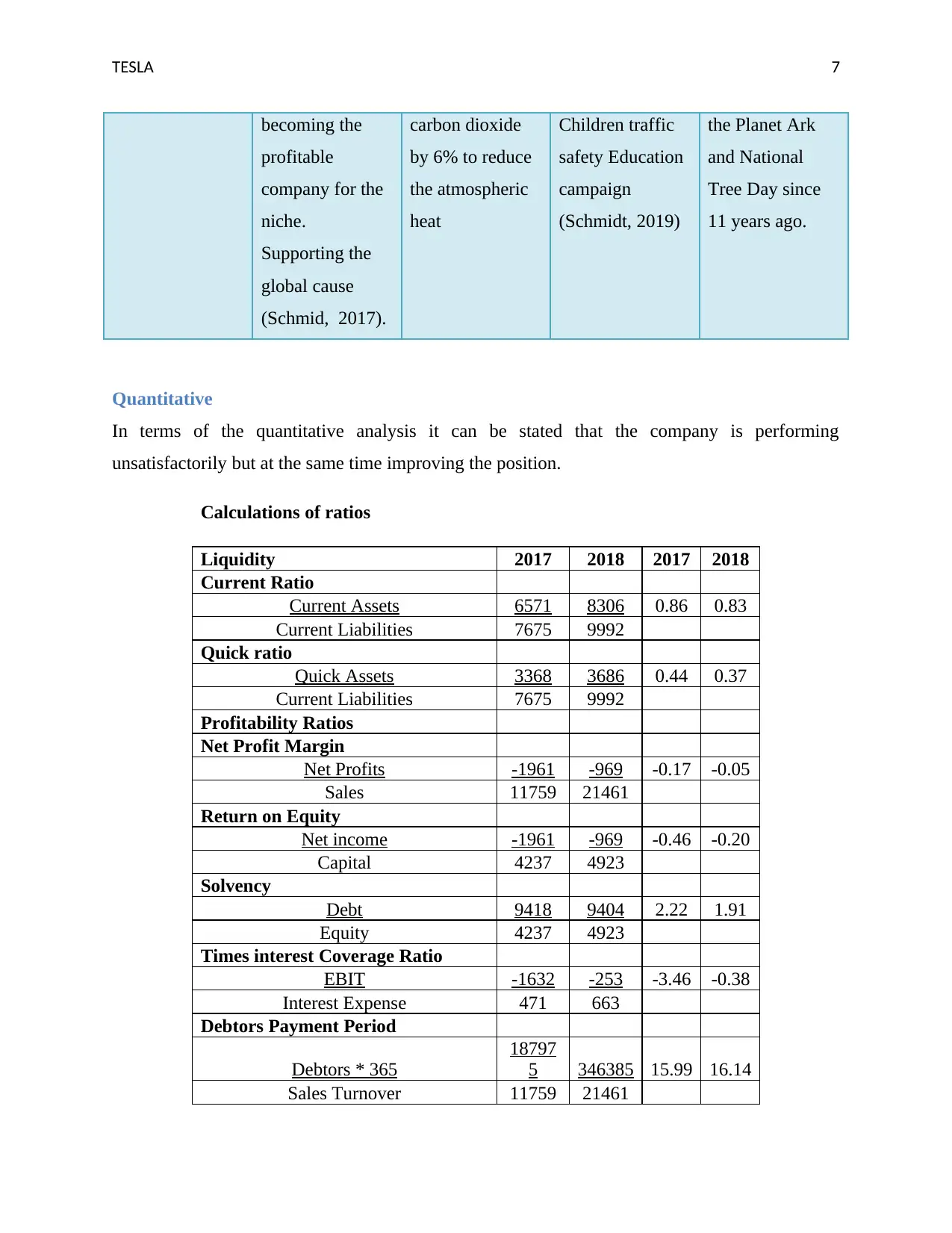
TESLA 7
becoming the
profitable
company for the
niche.
Supporting the
global cause
(Schmid, 2017).
carbon dioxide
by 6% to reduce
the atmospheric
heat
Children traffic
safety Education
campaign
(Schmidt, 2019)
the Planet Ark
and National
Tree Day since
11 years ago.
Quantitative
In terms of the quantitative analysis it can be stated that the company is performing
unsatisfactorily but at the same time improving the position.
Calculations of ratios
Liquidity 2017 2018 2017 2018
Current Ratio
Current Assets 6571 8306 0.86 0.83
Current Liabilities 7675 9992
Quick ratio
Quick Assets 3368 3686 0.44 0.37
Current Liabilities 7675 9992
Profitability Ratios
Net Profit Margin
Net Profits -1961 -969 -0.17 -0.05
Sales 11759 21461
Return on Equity
Net income -1961 -969 -0.46 -0.20
Capital 4237 4923
Solvency
Debt 9418 9404 2.22 1.91
Equity 4237 4923
Times interest Coverage Ratio
EBIT -1632 -253 -3.46 -0.38
Interest Expense 471 663
Debtors Payment Period
Debtors * 365
18797
5 346385 15.99 16.14
Sales Turnover 11759 21461
becoming the
profitable
company for the
niche.
Supporting the
global cause
(Schmid, 2017).
carbon dioxide
by 6% to reduce
the atmospheric
heat
Children traffic
safety Education
campaign
(Schmidt, 2019)
the Planet Ark
and National
Tree Day since
11 years ago.
Quantitative
In terms of the quantitative analysis it can be stated that the company is performing
unsatisfactorily but at the same time improving the position.
Calculations of ratios
Liquidity 2017 2018 2017 2018
Current Ratio
Current Assets 6571 8306 0.86 0.83
Current Liabilities 7675 9992
Quick ratio
Quick Assets 3368 3686 0.44 0.37
Current Liabilities 7675 9992
Profitability Ratios
Net Profit Margin
Net Profits -1961 -969 -0.17 -0.05
Sales 11759 21461
Return on Equity
Net income -1961 -969 -0.46 -0.20
Capital 4237 4923
Solvency
Debt 9418 9404 2.22 1.91
Equity 4237 4923
Times interest Coverage Ratio
EBIT -1632 -253 -3.46 -0.38
Interest Expense 471 663
Debtors Payment Period
Debtors * 365
18797
5 346385 15.99 16.14
Sales Turnover 11759 21461
Paraphrase This Document
Need a fresh take? Get an instant paraphrase of this document with our AI Paraphraser
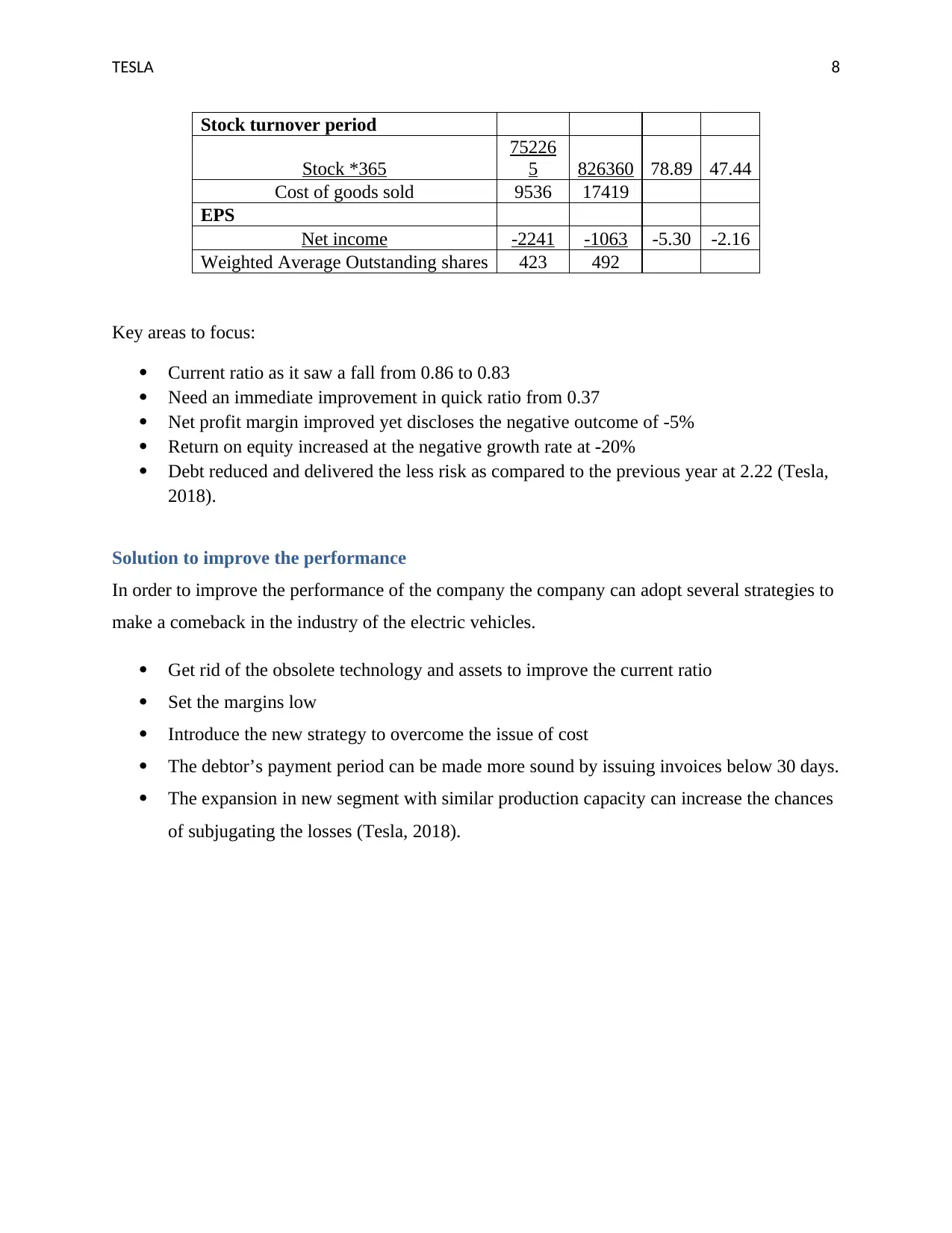
TESLA 8
Stock turnover period
Stock *365
75226
5 826360 78.89 47.44
Cost of goods sold 9536 17419
EPS
Net income -2241 -1063 -5.30 -2.16
Weighted Average Outstanding shares 423 492
Key areas to focus:
Current ratio as it saw a fall from 0.86 to 0.83
Need an immediate improvement in quick ratio from 0.37
Net profit margin improved yet discloses the negative outcome of -5%
Return on equity increased at the negative growth rate at -20%
Debt reduced and delivered the less risk as compared to the previous year at 2.22 (Tesla,
2018).
Solution to improve the performance
In order to improve the performance of the company the company can adopt several strategies to
make a comeback in the industry of the electric vehicles.
Get rid of the obsolete technology and assets to improve the current ratio
Set the margins low
Introduce the new strategy to overcome the issue of cost
The debtor’s payment period can be made more sound by issuing invoices below 30 days.
The expansion in new segment with similar production capacity can increase the chances
of subjugating the losses (Tesla, 2018).
Stock turnover period
Stock *365
75226
5 826360 78.89 47.44
Cost of goods sold 9536 17419
EPS
Net income -2241 -1063 -5.30 -2.16
Weighted Average Outstanding shares 423 492
Key areas to focus:
Current ratio as it saw a fall from 0.86 to 0.83
Need an immediate improvement in quick ratio from 0.37
Net profit margin improved yet discloses the negative outcome of -5%
Return on equity increased at the negative growth rate at -20%
Debt reduced and delivered the less risk as compared to the previous year at 2.22 (Tesla,
2018).
Solution to improve the performance
In order to improve the performance of the company the company can adopt several strategies to
make a comeback in the industry of the electric vehicles.
Get rid of the obsolete technology and assets to improve the current ratio
Set the margins low
Introduce the new strategy to overcome the issue of cost
The debtor’s payment period can be made more sound by issuing invoices below 30 days.
The expansion in new segment with similar production capacity can increase the chances
of subjugating the losses (Tesla, 2018).
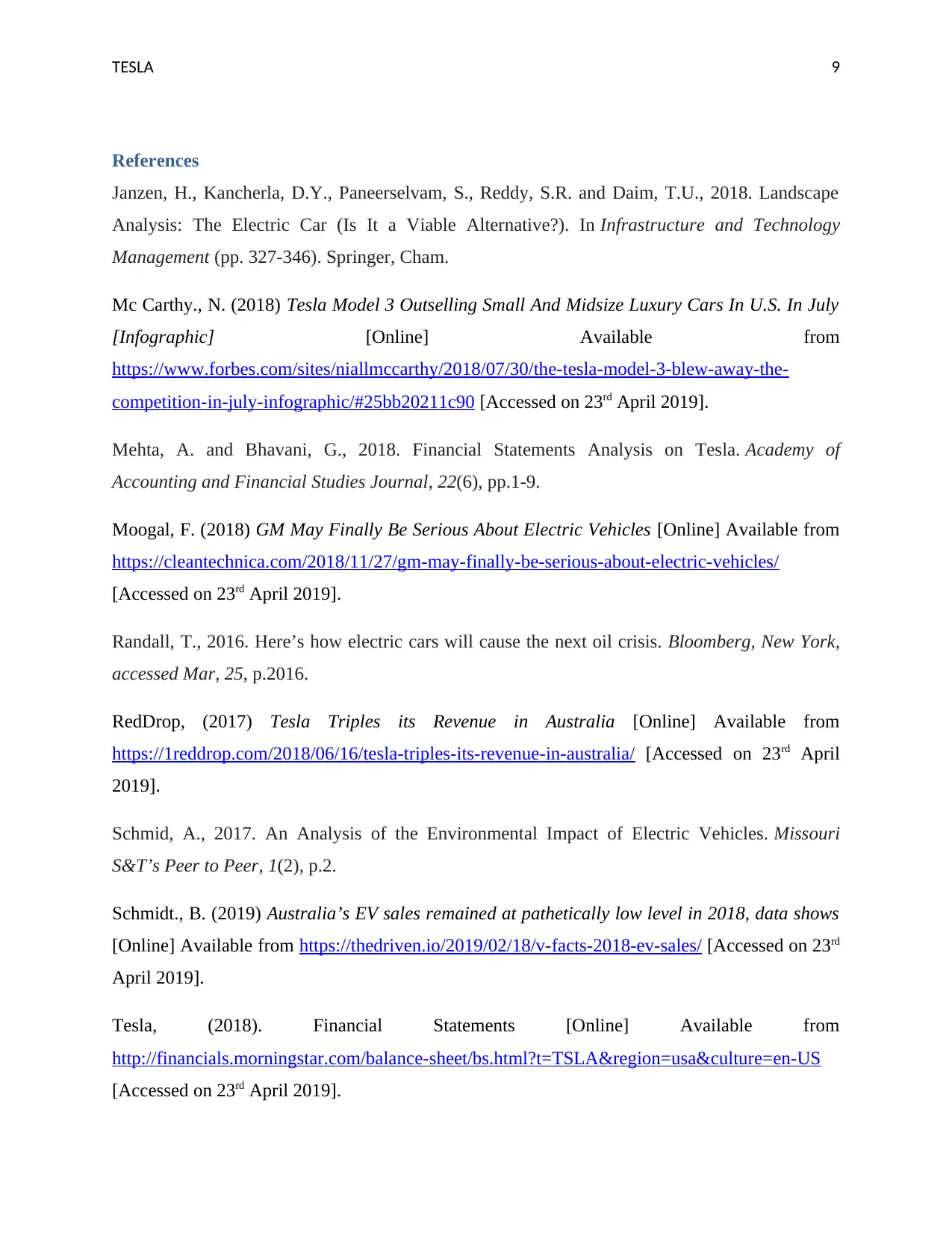
TESLA 9
References
Janzen, H., Kancherla, D.Y., Paneerselvam, S., Reddy, S.R. and Daim, T.U., 2018. Landscape
Analysis: The Electric Car (Is It a Viable Alternative?). In Infrastructure and Technology
Management (pp. 327-346). Springer, Cham.
Mc Carthy., N. (2018) Tesla Model 3 Outselling Small And Midsize Luxury Cars In U.S. In July
[Infographic] [Online] Available from
https://www.forbes.com/sites/niallmccarthy/2018/07/30/the-tesla-model-3-blew-away-the-
competition-in-july-infographic/#25bb20211c90 [Accessed on 23rd April 2019].
Mehta, A. and Bhavani, G., 2018. Financial Statements Analysis on Tesla. Academy of
Accounting and Financial Studies Journal, 22(6), pp.1-9.
Moogal, F. (2018) GM May Finally Be Serious About Electric Vehicles [Online] Available from
https://cleantechnica.com/2018/11/27/gm-may-finally-be-serious-about-electric-vehicles/
[Accessed on 23rd April 2019].
Randall, T., 2016. Here’s how electric cars will cause the next oil crisis. Bloomberg, New York,
accessed Mar, 25, p.2016.
RedDrop, (2017) Tesla Triples its Revenue in Australia [Online] Available from
https://1reddrop.com/2018/06/16/tesla-triples-its-revenue-in-australia/ [Accessed on 23rd April
2019].
Schmid, A., 2017. An Analysis of the Environmental Impact of Electric Vehicles. Missouri
S&T’s Peer to Peer, 1(2), p.2.
Schmidt., B. (2019) Australia’s EV sales remained at pathetically low level in 2018, data shows
[Online] Available from https://thedriven.io/2019/02/18/v-facts-2018-ev-sales/ [Accessed on 23rd
April 2019].
Tesla, (2018). Financial Statements [Online] Available from
http://financials.morningstar.com/balance-sheet/bs.html?t=TSLA®ion=usa&culture=en-US
[Accessed on 23rd April 2019].
References
Janzen, H., Kancherla, D.Y., Paneerselvam, S., Reddy, S.R. and Daim, T.U., 2018. Landscape
Analysis: The Electric Car (Is It a Viable Alternative?). In Infrastructure and Technology
Management (pp. 327-346). Springer, Cham.
Mc Carthy., N. (2018) Tesla Model 3 Outselling Small And Midsize Luxury Cars In U.S. In July
[Infographic] [Online] Available from
https://www.forbes.com/sites/niallmccarthy/2018/07/30/the-tesla-model-3-blew-away-the-
competition-in-july-infographic/#25bb20211c90 [Accessed on 23rd April 2019].
Mehta, A. and Bhavani, G., 2018. Financial Statements Analysis on Tesla. Academy of
Accounting and Financial Studies Journal, 22(6), pp.1-9.
Moogal, F. (2018) GM May Finally Be Serious About Electric Vehicles [Online] Available from
https://cleantechnica.com/2018/11/27/gm-may-finally-be-serious-about-electric-vehicles/
[Accessed on 23rd April 2019].
Randall, T., 2016. Here’s how electric cars will cause the next oil crisis. Bloomberg, New York,
accessed Mar, 25, p.2016.
RedDrop, (2017) Tesla Triples its Revenue in Australia [Online] Available from
https://1reddrop.com/2018/06/16/tesla-triples-its-revenue-in-australia/ [Accessed on 23rd April
2019].
Schmid, A., 2017. An Analysis of the Environmental Impact of Electric Vehicles. Missouri
S&T’s Peer to Peer, 1(2), p.2.
Schmidt., B. (2019) Australia’s EV sales remained at pathetically low level in 2018, data shows
[Online] Available from https://thedriven.io/2019/02/18/v-facts-2018-ev-sales/ [Accessed on 23rd
April 2019].
Tesla, (2018). Financial Statements [Online] Available from
http://financials.morningstar.com/balance-sheet/bs.html?t=TSLA®ion=usa&culture=en-US
[Accessed on 23rd April 2019].
⊘ This is a preview!⊘
Do you want full access?
Subscribe today to unlock all pages.

Trusted by 1+ million students worldwide
1 out of 9
Related Documents
Your All-in-One AI-Powered Toolkit for Academic Success.
+13062052269
info@desklib.com
Available 24*7 on WhatsApp / Email
![[object Object]](/_next/static/media/star-bottom.7253800d.svg)
Unlock your academic potential
Copyright © 2020–2025 A2Z Services. All Rights Reserved. Developed and managed by ZUCOL.





